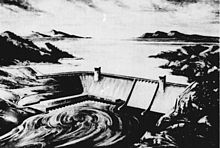Rampart Dam
| Rampart Dam | |
|---|---|

An artist's rendition of the proposed dam
|
|
|
Proposed location
|
|
| Official name | Rampart Dam |
| Location | Interior Alaska, United States |
| Coordinates | 65°21′00″N 151°00′00″W / 65.35000°N 151.00000°WCoordinates: 65°21′00″N 151°00′00″W / 65.35000°N 151.00000°W |
| Construction cost | $1.39 billion (1970 est.) |
| Operator(s) | U.S. Army Corps of Engineers |
| Dam and spillways | |
| Impounds | Yukon River |
| Height | 510 feet (155 m) |
| Length | 4,700 feet (1,433 m) |
| Reservoir | |
| Total capacity | 1.145 billion ac·ft (1,412 km³) |
| Catchment area | 200,000 square miles (517,998 km2) |
| Surface area | 9,844 square miles (25,496 km2) |
| Power station | |
| Installed capacity | 5872 MW |
The Rampart Dam or Rampart Canyon Dam was a project proposed in 1954 by the U.S. Army Corps of Engineers to dam the Yukon River in Alaska for hydroelectric power. The project was planned for Rampart Canyon (also known as Rampart Gorge) just 31 miles (50 km) southwest of the village of Rampart, Alaska and about 105 miles (169 km) west-northwest of Fairbanks, Alaska.
The resulting dam would have created a lake roughly the size of Lake Erie, making it the largest man-made reservoir in the world. The plan for the dam itself called for a concrete structure 530 feet (162 m) high with a top length of about 4,700 feet (1,430 m). The proposed power facilities would have consistently generated between 3.5 and 5 gigawatts of electricity, based on the flow of the river as it differs between winter and summer.
Though supported by many politicians and businesses in Alaska, the project was canceled after objections were raised. Native Alaskans in the area protested the threatened loss of nine villages that would be flooded by the dam. Conservation groups abhorred the threatened flooding of the Yukon Flats, a large area of wetlands that provides a critical breeding ground for millions of waterfowl. Fiscal conservatives opposed the dam on the grounds of its large cost and limited benefit to Americans outside Alaska.
Because of these objections, United States Secretary of the Interior Stewart Udall formally opposed construction of the dam in 1967, and the project was shelved. The U.S. Army Corps of Engineers nevertheless completed its engineering study of the project in 1971, and the final report was released to the public in 1979. In 1980, U.S. President Jimmy Carter created the Yukon Flats National Wildlife Sanctuary, which formally protected the area from development and disallowed any similar project.
...
Wikipedia

